Bicultural Healthy Living is the ability of immigrants and refugees to bridge two cultures, the American mainstream culture and their culture of origin, into one that allows them to live healthfully and happily. By leading a bicultural healthy lifestyle, we hope that Asian American and Pacific Islander (AAPI) communities can find a path that allow both their Asian/Pacific islander and American culture to co-exist with the ability to use one or both cultural protective factors when needed. This blog will explore the various ways and strategies to improve the health of AAPIs and the community as a whole by living a bicultural healthy lifestyle.
What Is Food Insecurity?
Food insecurity, a pervasive global issue, affects individuals and families across all economic strata, stemming from insufficient resources or restricted access to safe, nutritious food. Its ramifications extend beyond hunger, manifesting in compromised physical and mental well-being, diminished academic performance in children, and increased prevalence of chronic illnesses like diabetes and heart disease. Often synonymous with “food poverty,” it diverges from food shortages, which denote insufficient food supplies in a given area. Rather, food insecurity arises from economic challenges such as poverty or unemployment, rendering existing food resources inaccessible to certain demographics.
Food insecurity has a deeply rooted history in the United States, stretching back to colonial times when farmers grappled with erratic harvests. The Great Depression of the 1930s amplified this issue as widespread job losses left many without means to feed themselves. President Lyndon Johnson’s declaration of a “war on poverty” in the 1960s highlighted the nation’s growing concern over food insecurity, which has since remained intertwined with poverty. Presently, over 40 million Americans, roughly one in eight households, face food insecurity, impacting diverse demographics such as children, the elderly, low-wage earners, rural residents, and racial minorities. Moreover, women bear a disproportionate burden of this challenge.
Signs of Food Insecurity
Signs of food insecurity encompass skipping meals, reducing portion sizes, facing trade-offs between food and essential expenses like rent, and turning to food assistance programs for support.
Below, Verywell Mind has compiled a list of the most common signs of food insecurity:
- Shifting meal patterns—skipping meals, eating smaller meals, or relying on less expensive items like macaroni and cheese instead of healthier foods
- Inability to store food—food may spoil quickly due to lack of refrigeration or other storage solutions.
- Low energy levels—lack of nutritious foods can lead to fatigue, headaches, and other health issues.
- Worrying about running out of food—constant concern about having enough food for the family.
- Physical changes—weight loss or gain due to insufficient access to healthy diets.
Tips for Reducing Food Insecurity
Verywell Mind has also listed suggestions for individuals and communities seeking to alleviate food insecurity:
- Support food banks and other organizations that provide meals or groceries to those in need.
- Encourage local businesses to donate unsold items to food banks or other organizations.
- Advocate for public policies that prioritize access to nutritious foods in areas where food deserts exist.
- Volunteer at soup kitchens, shelters, or other local organizations providing meals for the hungry in your community.
- Educate yourself and others about the signs of food insecurity and how to identify it in your own life or that of another person.
- Start a community garden to provide fresh fruits and vegetables to those in need.
- Donate money or other items (e.g., canned goods, non-perishable foods) to organizations providing meals for the hungry in your community.
- Create a support system of family members, friends, neighbors, and co-workers who can help provide resources or meals when needed.
- Provide emotional support and understanding to those going through food insecurity—listen without judgment or offering unsolicited advice.
- Encourage public discussion about food insecurity—raise awareness by starting conversations with friends and family about the issue.
Food insecurity poses a significant global challenge, impacting millions and causing profound physical, mental, and social hardships. Engaging in actions like donating, volunteering, advocating for policy reform, and establishing support networks can significantly alleviate this issue for affected individuals and families. If you or someone you know is experiencing food insecurity, seeking assistance from organizations such as Feeding America can offer valuable support and resources.
Reference:https://www.verywellmind.com/what-is-food-insecurity-7097382
A Poem by Leah Lakshmi Piepzna-Samarasinha
Leah Lakshmi Piepzna-Samarasinha, known by both they/them and she/her pronouns, wears many hats as a writer, cultural worker, and disability justice advocate. They blend storytelling with technology, making it their primary tool for amplifying marginalized voices and advocating for transformative justice. As an Aries/Taurus with a penchant for creation and documentation, Leah has authored or co-edited numerous impactful books, including “The Future Is Disabled” and “Care Work,” while also contributing extensively to various publications like Eater and Disability Visibility Project.
Their collaborative spirit shines through in their work, as they often create performances and rituals alongside other disabled BIPOC creators, fostering spaces of belonging and empowerment. From curating poetry folios to crafting grief transformation portals, Leah’s contributions to the disability community are multifaceted and deeply resonant. Their commitment to storytelling as a means of resistance and healing, coupled with their dedication to centering marginalized voices, makes Leah a vital force in the ongoing pursuit of justice and liberation for all.
“my body is 40 miles of bad road”- working class krip saying
you mean well, but
when I say I hurt when I say some part of
my body hurts and you say oh, did you do something?
I hear what did you do? As is, it’s your fault,
there’s cause and effect and there’s a simple
story, and if a + b = c we can fix it
fast.
But there’s no simple story in this body.
She falls apart whenever she feels like it,
which is often. She doesn’t feel like going to
work or up and down three flights of stairs, and she’ll tell you all about it.
She can smell the weather.
She got a lot of stories
and just like her mama did at slam church two decades ago,
she spits them out my kneecap like a gun with chaotic
yet accurate aim.
She is forty miles of perfect bad road
all bumps and potholes that could take out your wheel.
You gotta know how to drive it.
You gotta not be too worried about breaking your car
(because she’s already broke too)
I mean, I could tell you, everything happened! I could tell you my mama
molested me, I could tell you hers did too,
I could tell you we had to walk a long long way and get on a boat,
I could tell you I moved to brooklyn for love but there’s a lot of stairs here too
I could read you the particulate matter of the air, that they’re spraying for pesticides today
that I ran out of the fish oil that greases my knee into smoothing,
and I don’t know if the CVS sells it here
– but does anyone want to hear all that?
The staying chant
the recitation
of everything that’s happening in my body, and their body,
and the park’s body, and on the subway huffing diesel and cigarettes
When you say it’s just pain for no reason all the time, fibro, right?
I say, close but no cigar!
I say I intimate with pain tides
This ground not steady! Why would it be?
As soon as I figure it out she flips me the bird
shapeshift hip transforms and says fuck you, you figure it out
Sometimes the place where my mama threw me into the wall
at three and broke my sacrum talks to me,
locks all my earth into cement.
Some days I don’t know what day it is.
Some days my ass leaks tidal marsh, briny river
Some times everything everything
everything every thing
hurts
like a church bell
like a call to prayer
and it calls me to pray
this pain
breathing into any place that doesn’t hurt
some of which only exists in my revolutionary imagination.
Sometimes you have to talk quiet.
Sometimes I can’t talk at all.
Of course you don’t believe that, but I feel the need to declare:
my life is worth living anyway
I love every jounce on this bad, bad
underfunded budget cut frost heave road
not everyone’s car can make it down;
you gotta know
how to drive it
I love every car that just gave up in the mountain pass
every hubcap that fell off
every- yes- road not on any map
every rock and resisting
every reason this happened
every reason this body
is reason enough
for being.
LEAH LAKSHMI PIEPZNA-SAMARASINHA
In essence, Leah Lakshmi Piepzna-Samarasinha epitomizes the power of storytelling and creative expression as tools for liberation and social change. Their multifaceted roles as a writer, cultural worker, and disability justice advocate underscore the importance of centering marginalized voices in narratives of identity, culture, and gender. Through their work, Leah champions the freedom of expression, weaving together stories that honor the complexities of lived experiences and challenge systems of oppression. By amplifying the voices of disabled BIPOC creators and advocating for transformative justice, Leah embodies a commitment to creating inclusive spaces where all individuals can authentically express themselves and thrive. Their contributions serve as a beacon of hope and inspiration for a more equitable and compassionate world.
Reference:https://www.poetryfoundation.org/poems/159971/bad-road https://brownstargirl.org/
The Art of Antonius-Tin Bui
Antonius-Tin Bui, a versatile Vietnamese American artist, showcases three distinct bodies of work in the exhibition: “Do not laminate this card,” “Not Sorry for the Trouble,” and two portraits. Each piece delves into the enduring challenges and stereotypes faced by AAPI individuals, while also reflecting Bui’s exploration of unconventional beauty through the medium of paper. “Do not laminate this card” comprises laminated collages juxtaposing images from the Vietnam War era with ancestral burning paper or joss paper. Originating from Bui’s 2017 trip to Vietnam, where they faced criticism from a U.S. government official for laminating their security card, this series is a poignant commentary on identity and heritage. (Voice of OC respects Bui’s choice of preferred pronouns, “they/them.”
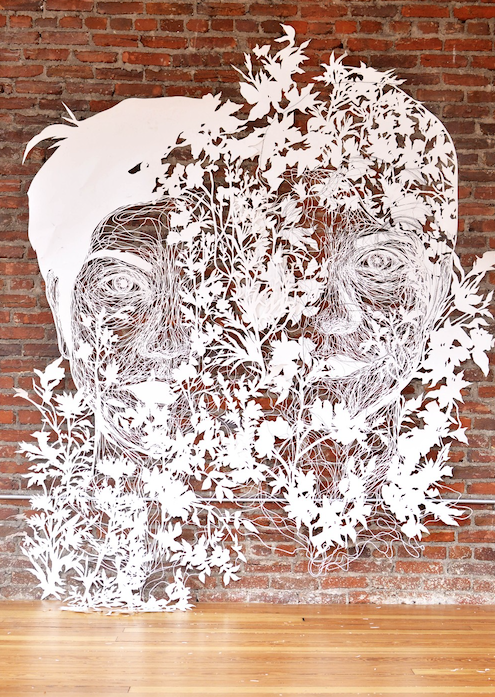
Photo: Antonius-Tin Bui
Since completing their degree in 2016, Antonius has been fortunate to receive fellowships from esteemed institutions such as the Vermont Studio Center, Kala Art Institute, Tulsa Artists Fellowship, Halcyon Arts Lab, and Houston Center for Contemporary Craft. These opportunities have allowed them to diversify their artistic practice, extending beyond hand-cut paper techniques. Currently, Antonius explores themes of Vietnamese history and queerness through various mediums including performance, textiles, and photography. Their work has been showcased at a wide array of venues, ranging from institutional to underground, including the Vietnam Veterans Memorial, Smithsonian Arts & Industry Building, Corcoran Gallery of Art, Hillyer Art Space, Lawndale Art Center, Living Arts, 108 Contemporary, Artscape, and the Philbrook Museum.
Antonius’s art intricately weaves together narratives of culture and identity, crafting pieces that transcend time with their enduring beauty. Each work serves as a tribute to cultural heritage, radiating a unique elegance that captivates and inspires viewers. Through their art, Antonius breathes life into stories that resonate deeply, inviting audiences to immerse themselves in the rich tapestry of human experience.
Heritage Vocabulary
- 文化 (wénhuà) – Culture
- 身份 (shēnfèn) – Identity
- 经典 (jīngdiǎn) – Timeless
- 美丽 (měilì) – Beauty
- 故事 (gùshì) – Story
Reference: https://voiceofoc.org/2022/12/yellow-submarine-rising-gives-asian-american-artists-a-platform-to-speak-and-shine/.
The Art of Roshan Ganu
Originally hailing from Goa and now based in Minneapolis, Roshan Ganu is a versatile multimedia artist. Through her practice, she explores the depths of human experience using light, darkness, motion, space, and time. Her fascination lies in the intricate connections between language, visuals, experiences, and various disciplines. Ganu’s creations breathe life into narratives, moments, and emotions, inviting viewers into a realm of vulnerability. Central to her artistic vision is the theme of “isolation,” which serves as a lens through which she examines the human condition.
Observing her art is akin to observing the cosmos, capturing the profoundness of depth, space, texture, color, and time. Ganu’s art is inherently interdisciplinary, seamlessly intertwining cultural influences with her own unique and personal perspectives, enriching her work with layers of depth and meaning. Her art transcends boundaries, offering viewers a glimpse into the interconnectedness of humanity and the universe, evoking introspection and contemplation on the complexities of existence.
Formal language is a means to our consciousness. But consciousness itself knows no formal language. I am interested in a transdisciplinary translation of concepts and the fluidity of our human experience. I speak and understand six languages: Marathi, Konkani, Hindi, English, French, and Portuguese. Each language ignites its own consciousness and in each language I understand myself differently. The immigrant experience complicates this by introducing a foreign context. I am interested in this interflow of meaning in a multilingual and multicultural framework.
Roshan Ganu
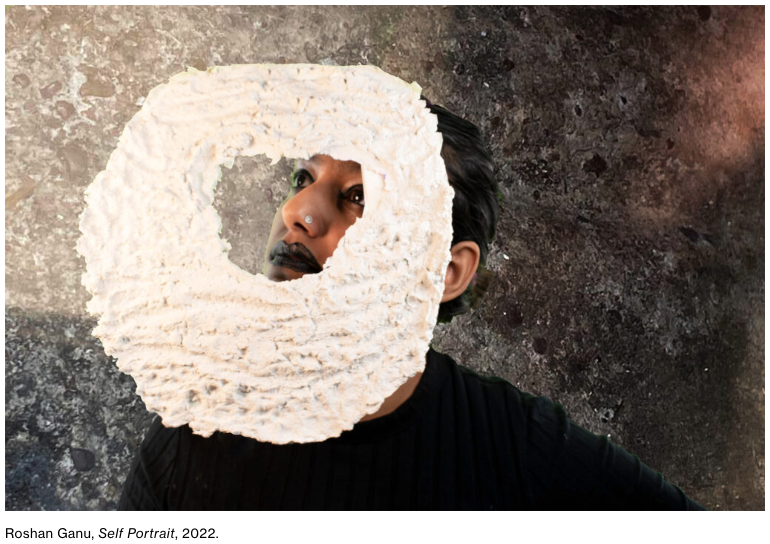
In a world defined by diversity and cultural richness, creative expression serves as a vital conduit for celebrating our multifaceted identities and bridging differences. Through the lens of art, encompassing language, heritage, and culture, we find a common ground where individual narratives coalesce into a harmonious tapestry of human experience. The borderless nature of artistic expression transcends geographical confines, fostering connections that traverse continents and cultures. As we embrace the kaleidoscope of perspectives and voices, we cultivate a universal environment of understanding and empathy, paving the way for peace and unity in our global community. In cherishing and preserving our cultural heritage while embracing innovation and diversity, we illuminate the path towards a more inclusive and compassionate world, where art becomes a catalyst for profound transformation and collective harmony.
Reference: https://mnartists.walkerart.org/roshan-ganu-language-and-illusion http://www.roshanganu.com/
Try a Healthy Eating Plan to Reduce Stress
One factor contributing to weight gain among busy, stressed individuals is their tendency to opt for fast food or dining out more frequently. This inclination is understandable; after a hectic day, there may be little time or energy left to prepare a meal from scratch at home. However, prioritizing healthy eating habits at home can assist in preventing unwanted weight gain during stressful periods, as homemade meals typically offer superior nutritional value compared to fast food options. Additionally, homemade meals often feature smaller portions and lower fat content than restaurant offerings. Moreover, cooking at home can lead to financial savings, indirectly alleviating stress by reducing financial strain. While the idea of cooking a nutritious or unfamiliar dish after a long day may seem daunting, it is more manageable than one might imagine. Here are some convenient and straightforward guidelines to help incorporate healthier meals into your home-cooking routine.
- Plan ahead
- Keep it simple
- Cook ahead
- Use a crock-pot
- Try an instant pot
There is a huge wealth of recipes for the Instant Pot, as well as online communities and recipes for those who are learning to use them.Verywell Mind
Getting into the habit of eating healthy and planning meals ahead can greatly reduce stress, and also reduce the strain on your wallet. Diet and mental health are closely related, eating healthy also improves ones mental health and well-being. It’s important to eat fresh veggies, stay hydrated, and lower sugar, salt, and processed foods. Keeping these guidelines can be beneficial in your daily life.
Reference: https://www.verywellmind.com/healthy-eating-plan-to-reduce-stress-3144530
The Artist John Hasegawa

Photo Credit: John Hasegawa
Native to Seattle, Washington, Associate Professor John Hasegawa leads the Ceramics department at Mt. Hood Community College, where he instructs students in both introductory and advanced levels of ceramic artistry. His educational journey commenced with a Bachelor of Arts degree from the University of Puget Sound, where he pursued a dual major in Philosophy and Mathematics, followed by a second Bachelor of Arts degree in Art. Continuing his academic pursuit, he attained a Master of Fine Arts degree in Ceramics from the University of Oregon.
“I have created some mizusashi and when I think about it, it’s really my version of them because that’s a very Japanese thing. There’s probably all these rules, but I was looking at what these Japanese artists were and trying to reinterpret them back into my Japanese American aesthetic.”
John Hasegawa
Throughout his career, John has imparted his expertise at various institutions across the United States, including Emporia State University in Kansas, Worcester Craft Center in Massachusetts, Armory Art Center in Florida, University of Oregon, and University of Massachusetts – Dartmouth. Notably, he recently relocated from Paducah, Kentucky, where he enriched the artistic community by teaching Ceramics, 3-D design, and Digital Photography at the Paducah School of Art.
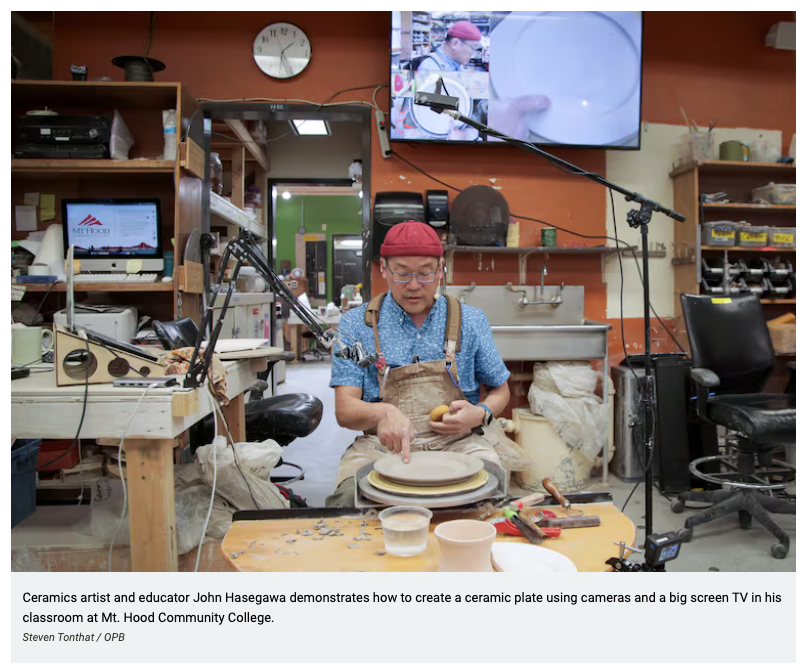
John’s artistic endeavors extend beyond the classroom, with his works showcased in exhibitions nationwide, earning him numerous accolades for his contributions to the field of ceramics. Johns work highlights subtle and elegant detail, modern and traditional; his work is creative and timeless.
Reference:https://www.johnhasegawa.com/ https://www.opb.org/article/2023/12/10/john-hasegawa-uses-pottery-to-explore-asian-american-identity/
The Versatility of Buddhist Cuisine
Rooted in compassion for all life, non-violence, and mindfulness, Buddhist cuisine is one of the hallmarks of vegetarian cooking. As Buddhist practice traveled across Asia and to the West, the doctrines influenced the diet of the Buddhist community, creating a colorful and harmonious culinary culture. In some Buddhist communities there are quite strict dietary regulations that must be observed, such as not eating any strong or pungent vegetable or seasoning. This means that onions, garlic, leeks, chives, shallots, and ginger, would not be used. In other sects these flavors are acceptable so as long as they are used sparingly, or to just add enough flavor, nothing to excite the taste buds too much. Regardless of what is used, so as long as it is prepared mindfully and for the benefit of sustaining life it is acceptable.
Many Buddhists in the Theravada tradition eat meat, however some also observe a vegetarian diet as well. One surprising fact is that the Buddha was not actually a vegetarian, he did eat meat only if it were offered to him. In China, tofu became a major source of protein for the Buddhist communities practicing the Mahayana tradition. Tofu is packed with nutrients, protein, and iron, it’s also flavorful and very filling too!. When mashed it can be used in mock meat dishes, when sliced it can be fried, hence the reason it’s such a popular choice food among vegetarians across the world. Some studies have shown that tofu can even reduce the risk of cancer and heart disease.
Vietnamese Buddhist cuisine is light and refreshing, and also uses lots of tofu. In vietnam many kinds of mock meats are made by using dried tofu skins and wheat gluten (Mock duck). One very versatily and exceptionally yummy vegan dish is Vietnamese vegan ham. This mock ham has a light flavor, with hints of black pepper and essence of bamboo leaves. Its often eaten on it’s own or in banh mi, noodles, and soups. If you have never tried Buddhist cuisine immerse yourself in your local Buddhist communities, there is a wealth of knowledge that has survived generations. Buddhist chefs have mastered the art of mindful cooking, this way of preparing ones meals can be helpful in our daily lives, it teaches us that we can prepare a lot with just a little, and to appreciate the food as nourishment for the body, mind, and the heart.
The Beauty of Asian American Art
Asian American art tells a story of pride, history, culture, and identity. It beautifully weaves cultural diversity and fusion, embracing the three times, present, past, and future. It tells the stories of families, of philosophy, and also it expresses the strength and resilience of the AAPI communities. Within this unbroken view, Asian American art also expresses the cultural identities of East Asia, South East Asia, South Asia, and beyond, welcoming collaboration from many cultural diasporas. In this blog post we will highlight the beautiful art of a few AAPI artists.
“Art has really been the way I have been able to understand both cultures, and to undo the wrongdoing of both cultures.”
~Bernice Bing, abstract/expressionist painter
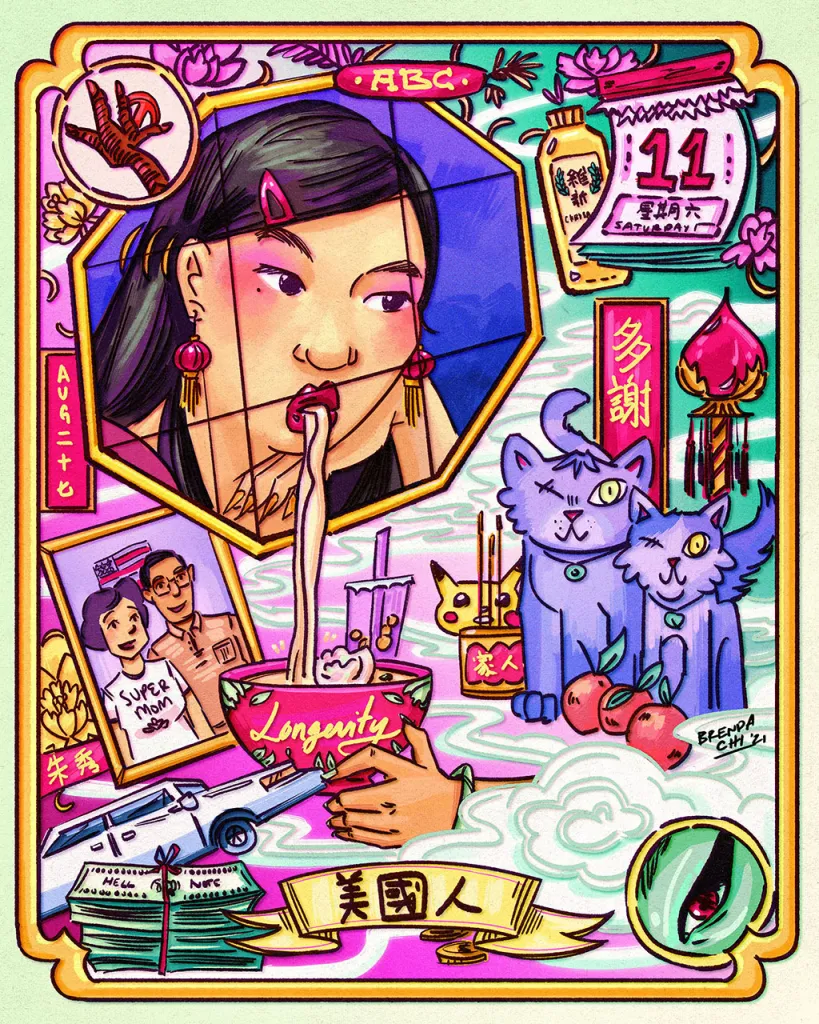
Brenda Chi
“I am currently comforting and celebrating my AAPI heritage through food, celebration of AAPI culture, language, and my family. This can also be seen as a self-portrait, as much of my identity is being an AAPI artist, so everything connects. This illustration features some of my favorite childhood foods, listening and speaking in Cantonese, celebrating my ancestors’ beauty through my self-expression, burning joss paper, praying to my family to wish us well, gratitude to my family, and claiming my space as an American Born Chinese (ABC) woman. This piece is inspired by vintage Chinese cigarette advertisements, which I’ve interpreted into a more intentional Chinese American illustration, with colors inspired by Cantonese Rose patterned porcelain. As a second generation Chinese immigrant, I often find myself researching my own Cantonese heritage as much hasn’t been taught to me. As I create this art, I am also learning about my AAPI heritage, which I think is really healing for anyone in Asian diaspora.”
Brenda Chi is a multidisciplinary artist and art director based in Los Angeles. View more of Brenda’s work here: Portfolio / Instagram.
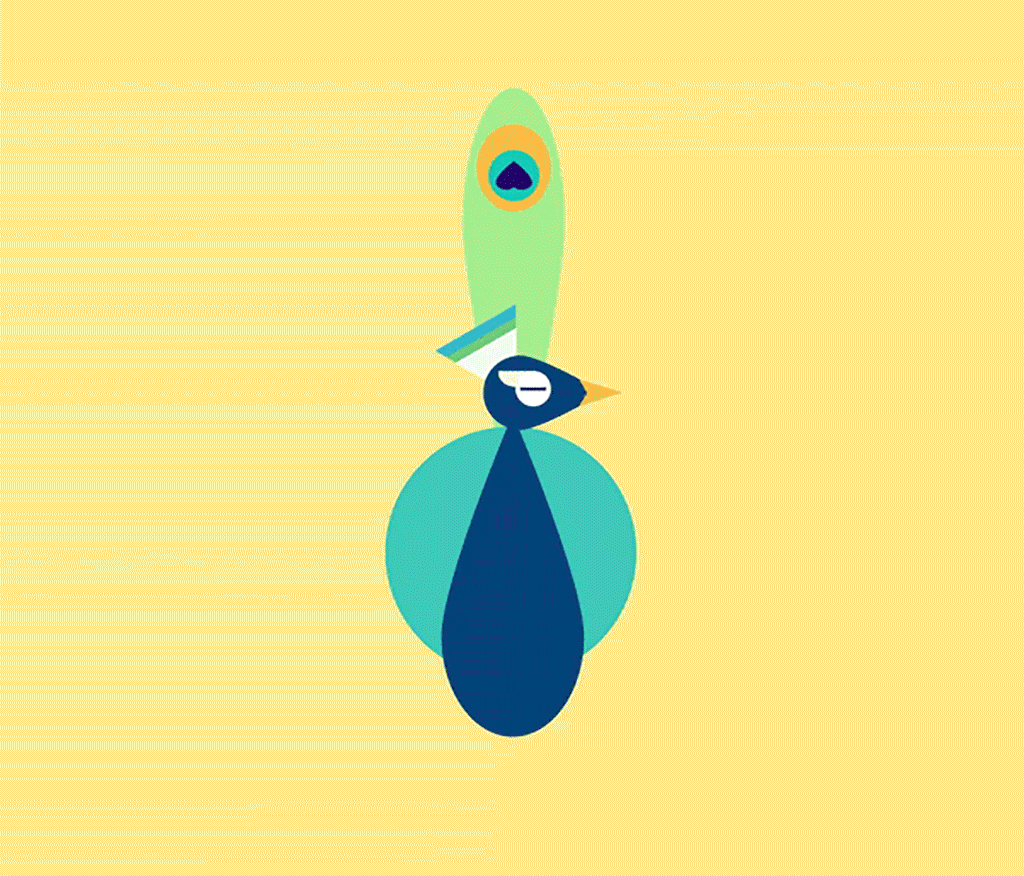
Ameena Fareeda / Eye Open at the Close
“Growing up Indian-Asian American, there were many instances in which I struggled with connecting to my identity. I would feel as though I played tug-of-war with my own Asian and American personas. As I got older, I learned to appreciate my culture and identity as a proud Asian American. The peacock is the national bird of India which symbolizes race, pride, and beauty. A peacock’s feathers are truly iconic. They spread not only for mating purposes, but also for means of boasting and protection. The feathers’ resemblance to eyes are known to be a symbol to ward off bad luck and attract positivity.
Eye Open at the Close represents how I navigate in today’s society as an Indian-Asian American. In light of the recent increase in hate crimes towards the AAPI community, it is vital to preserve and uplift the diversity, strengths, and uniqueness within the community. Eye Open at the Close raises awareness to the public eye and expresses how strong and beautiful the AAPI community truly is.”
Ameena Fareeda is an illustrator and designer based in Silver Spring, Maryland. View Ameena’s work here: Portfolio / Instagram.

Eunsoo Jeong / Koreangry
“I’ve been making zines since 2016, and it has been my way of expressing myself. It started as a means to cope with my anxiety and depression but over the years, I’ve gained the confidence to own those narratives and turn it into humor. As a formerly undocumented immigrant, I had a hard time connecting with my identity as an Asian American, because I didn’t see many undocumented Asian Americans and didn’t know how to celebrate or to have pride within myself. In early 2020, I published Koreangry zine issue #8, that featured my Korean American history timeline after conducting self-driven research to understand and see what my roots were in this country. This showed me different perspectives on how we can define our identities regardless of what we are told to believe based on our immigration status in this country. By making zines based on my life experiences, I was able to connect with lots of AAPI folks across the country who could relate to my stories. During the grueling pandemic year, I felt isolated and lonelier than usual. Throughout that time, I pushed ideas that may challenge our AAPI communities (confronting anti-Blackness, defunding police), provided educational and informative comics (know your rights during protests, bystander intervention), and shared vulnerable confessions of my struggles and experiences living in this country today.
This artwork is a collage of my yearning desire to do ‘good’ despite the challenging struggles of being an immigrant today during the pandemic––the pressure of being a good, kind, nice, humble, grateful, by-the-book immigrant. Sharing my story through zine-making is how I connect with other AAPI groups, by accepting and rejecting, challenging, rebuilding, and redefining what our identities could be.”
Eunsoo Jeong is an artist based in Los Angeles. View more of Eunsoo’s work here: Portfolio / Instagram.
By creating art we honor our ancestors, respect our cultures, and learn about other cultures. Creating art is a way to promote peace and freedom of expression. It joins forces, strengthens roots, and leaves a wider and beautiful landscape for future generations to enjoy. Art is our voice, heart, and soul, to create art means to be present with all of who you are.
Heritage Art Vocabulary in Mandarin
- 艺术 ( Yi shu ) – Art
- 文化 ( Wen hua ) – Culture
- 画画 ( Hua hua ) – Drawing
- 戏剧 ( Xi ju ) – Drama
- 表演 (Biao yan) – Performance
Reference:https://www.yesmagazine.org/social-justice/2021/05/28/asian-american-artists-aapi-heritage
Embracing Your True Self
Have you ever sat down and thought to yourself ” Who am I’, or “What is my life purpose”?. These thoughts have crossed many of our minds, and sometimes we actually may not have an immediate answer, and this is ok. In one’s journey on this planet we are constantly learning, and through learning our world we can learn about ourselves. To embrace one’s true self means to fully accept who you are. Society, and even family expectations can make it challenging, but this journey is yours.
Embracing yourself requires reflection, contemplation, going within your mind to know your mind. It is a process, a moment in life for you to be totally present with your being. All of who you are is here today, to live and to experience this world. When you can embrace yourself, you can walk with confidence and a pure heart. Oftentimes there are moments when we feel a little insecure, or a bit anxious, it may be because of what someone has said, or maybe a different reason. Whatever that reason may be, remember that all of existence has formed you in the here and the now, let go of any negativity and continue shining bright in the world.
To embrace yourself is to be beautiful, you are going against the expectations of others and living a life that is true to you. It is liberation, it is joy, it is inner-peace, this is what it means to embrace yourself. Our cultures are unique, ancient, diverse, and we all reflect the beauty of our cultures. Embracing yourself also means to embrace your cultural heritage, and in fully embracing who you are, you become a light that can guide others in doing the same. Let us make the world a beautiful place.
Jarrelle
Healing Through Art
Healing can take many forms, through movement, through sound, or through visual expressions; art has been used to speak when words can not. Since the Covid-19 pandemic many Asian Americans have taken up different forms of creative and artistic approaches in combating trauma and fostering healing. In this blog post we will share a few pieces of visual art that paints a picture of hope, healing, and identity.
Nicole Kang Ahn (b. 1988)
Remembrance, 2022
Digital print on Polyvinyl Chloride (PVC)
Remembrance is based on a photo taken by the artist during a visit to the makeshift memorial at Gold Spa in the days following the shooting. It captures a moment of quiet reflection – a young girl and her grandmother lean on each other for support, surrounded by flowers and handwritten dedications. It is a reminder that while our wounds are intergenerational, so too are the ways we show caring and healing.
“I wanted to first remember the victims.”
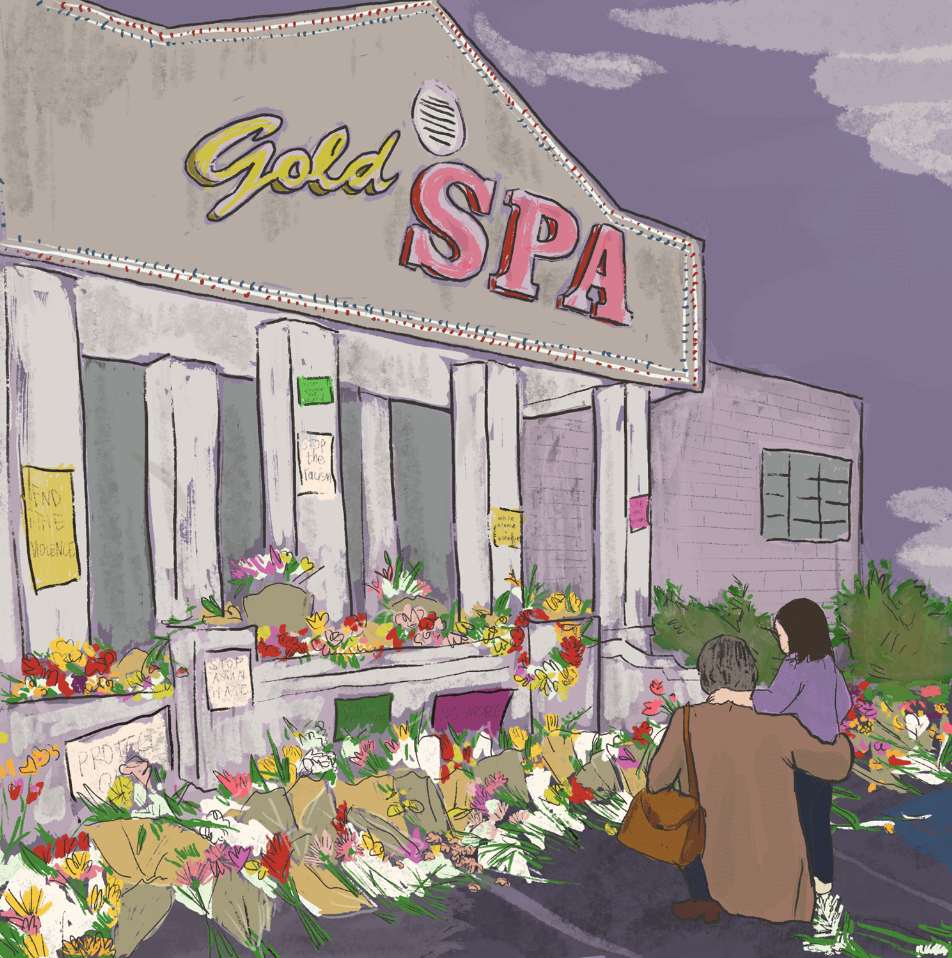
Nicole Kang Ahn (b. 1988) is a painter, illustrator, and muralist from Peachtree Corners, Georgia. Her art means to slow down time and capture mundane moments, savoring each feeling and memory. Her three pieces included in this collection seek to tell a story that remembers the victims, honors their lives, and conveys a message of hope.
Image Description: This artwork is about remembrance. This is an illustration of the Gold Spa store front where an altar of community notes and flowers are sprawled across the front of the spa and an elder with short dark hair, a brown long sleeve shirt, and brown bag is kneeling and embracing a young child with brown shoulder-length hair, wearing a purple long sleeve shirt looking towards the altar. The Gold Spa was the site of one of the shootings that took place on March 16, 2021.
Natalie Bui (b. 1992)
Community Care, 2022
Digital print on Polyvinyl Chloride (PVC)
In Vietnamese, the expression “chia buồn” is used to express condolences. “Chia buồn” literally translates to “divide sadness.” The expression captures the act of dividing grief – of cutting it into small, little, pieces to split among each other so that each of us individually carries a much lighter load. Community Care shows four figures locked in a comforting embrace. Their limbs are entangled and each person leans on the collective, both resting upon and supporting those around them.
Community care requires us to harness our power, privilege, and empathy to uplift the people who are both in and out of the reach of our embrace. In the wake of the anniversary, this piece inspires us to recommit to expanding and deepening our community of care for all, beginning in Atlanta and spreading throughout the country and the world.
“We were talking about a traumatic moment within our movement. But also trying to balance the acts of community care when these moments happen.”

Natalie Bui (b. 1992) is a Vietnamese American digital illustrator and co-Founder of SHIFT – a diversity, equity, and inclusion consultancy. Her work centers on self and community empowerment and emphasizes collective liberation across communities.
Image Description: The theme of this artwork is community care with four women embracing one another and the words “CAN I HOLD YOU?” below the image. The women appear with different hair styles in different shades of purple and different shades of orange, pink and red on their skin. There are shades of purple and blue leaves coming out from behind the two women at the end of each embrace and shades of orange, pink, purple and magenta flowers on the women’s skin. The backdrop of this image shows a gradient of orange and pink flowers.
Nicole Kang Ahn (b. 1988)
Solidarity, 2022
Digital print on Polyvinyl Chloride (PVC)
In this illustration, a diverse group of people of all races, genders, ages, and dis/abilities is featured in the foreground. They are holding boldly colored signs that call attention to a range of social and political issues that are often framed as separate, but are actually deeply intertwined. The shadowed figures behind them gesture to the powerful histories of resistance and community organizing that came before them. As we mark the anniversary of the Atlanta shooting, this piece reminds us that this tragedy is steeped in layers of oppression and interconnected histories of systemic violence. As such, it is a call to action to come together for a more powerful response rooted in love and solidarity.
“Gather together with other people. Align your issues and your values and do something about it.”
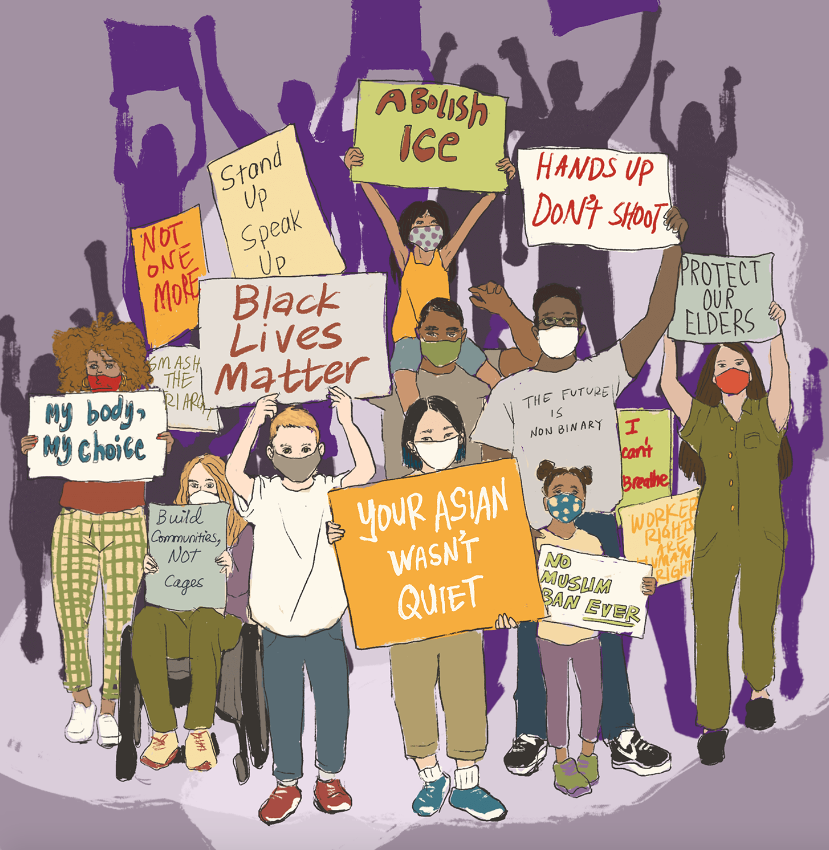
Image Description: This image is all about racial solidarity with a diverse group of people of all races, genders, ages, and dis/abilities holding signs that read “YOUR ASIAN WASN’T QUIET; NO MUSLIM BAN EVER; WORKERS RIGHTS ARE HUMAN RIGHTS; I CAN’T BREATHE; THE FUTURE IS NON BINARY; PROTECT OUR ELDERS; HANDS UP DON’T SHOOT; ABOLISH ICE; BLACK LIVES MATTER; Stand Up Speak Up; NOT ONE MORE; Smash the Hierarchy; My body, My choice; BUILD COMMUNITIES NOT CAGES.” The people holding up signs appear centered on the image with shades of purple shadows behind them.
The diversity within the Asian community is vast and covers many languages, beliefs, and traditions. By creating art communities join forces in shared experiences, creating a universal language that goes beyond differences. Art unifies diversity within the Asian communities by sharing narratives, personal expression, and one’s own personal journey. Embracing art as a form of healing gives birth to the celebration of one’s own cultural heritage, diversity, and resilience.
Reference:https://www.advancingjustice-atlanta.org/art-exhibit
